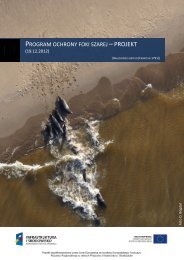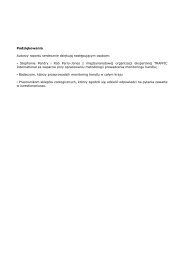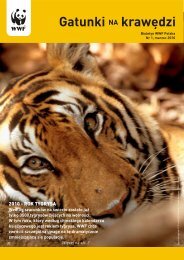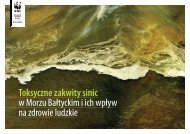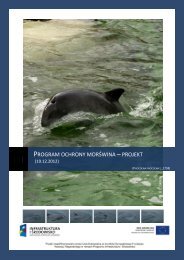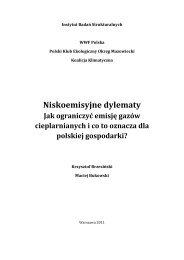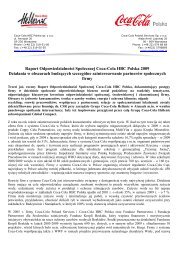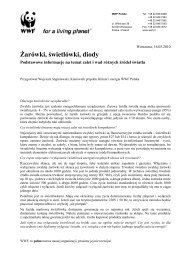COLLECTING GHOST NETS IN THE BALTIC SEA - WWF
COLLECTING GHOST NETS IN THE BALTIC SEA - WWF
COLLECTING GHOST NETS IN THE BALTIC SEA - WWF
Create successful ePaper yourself
Turn your PDF publications into a flip-book with our unique Google optimized e-Paper software.
© <strong>WWF</strong> / W. Wójtowicz<br />
Sport and recreational fishing may<br />
present a danger for marine<br />
ecosystems in the littoral zone.<br />
In addition to the above examples from the academic<br />
and practical spheres, another important<br />
source of information on the issue of ghost nets<br />
as marine debris is educational materials, including<br />
publications of a more popular character. An example<br />
of such literature is the report by the Londonbased<br />
World Society for the Protection of Animals. 13<br />
1.2. Summary of the pilot project<br />
“Collecting ghost nets in the Baltic<br />
Sea” conducted in 2011<br />
The recently published NOAA technical memorandum<br />
11 is concerned with optimising the strategy of<br />
locating lost fishing gear and the choice of appropriate<br />
fishing management methods. Although it refers<br />
to specific basin and trap devices, the report is<br />
noteworthy in view of the hydroacoustic equipment<br />
used, the choice of search areas in cooperation<br />
with fishermen and on the basis of the information<br />
provided by them concerning the location of traps<br />
and the most likely reason for their loss (with theft<br />
and vandalism mentioned as some of the most<br />
important reasons). Meanwhile, a recent publication<br />
by Korean authors indicates that also sport and<br />
recreational fishing may present a danger for<br />
marine ecosystems in the littoral zone. 12<br />
11<br />
Clark, R., S.J. Pittman, T.A. Battista, and C. Caldow (eds.).<br />
2012. Survey and impact assessment of derelict fish traps in<br />
St. Thomas and St. John, U.S. Virgin Islands. NOAA Technical<br />
Memorandum NOS NCCOS 147. Silver Spring, MD. 51 pp<br />
12<br />
Macfadyen, G. et al. 2013: Impacts of marine debris on wild<br />
animals in the coastal area of Korea. Marine Pollution Bulletin 66<br />
(2013) 117-124.<br />
The principal goals of the pilot project implemented<br />
in 2011 were as follows:<br />
• estimating the quantity of ghost nets in the Baltic<br />
Sea and other basins and evaluating the role<br />
of shipwrecks as locations where lost fishing<br />
gear accumulates;<br />
• assessing the feasibility of estimating the fishing<br />
capacity of ghost nets and their impact on the<br />
Baltic fish populations;<br />
• listing the main causes of the presence of ghost<br />
nets;<br />
• presenting information on the national and EU<br />
regulations concerning abandoned and lost<br />
fishing gear, its removal and disposal;<br />
• conducting open sea operations involving searching<br />
the sea bottom for ghost nets;<br />
• trial diving operations to retrieve ghost nets<br />
from shipwrecks.<br />
To attain the established goals, a method was<br />
developed in order to estimate the quantity per year<br />
of lost fishing gear that is most likely to turn into<br />
ghost nets, i.e. set nets used in cod and flounder<br />
13<br />
Butterworth, A., Clegg, I., Bass, C. 2012: Untangled – Marine<br />
debris: a global picture of the impact on animal welfare and of<br />
animal-focused solutions. London: World Society for the Protection<br />
of Animals.<br />
6 <strong>COLLECT<strong>IN</strong>G</strong> <strong>GHOST</strong> <strong>NETS</strong> <strong>IN</strong> <strong>THE</strong> <strong>BALTIC</strong> <strong>SEA</strong>



